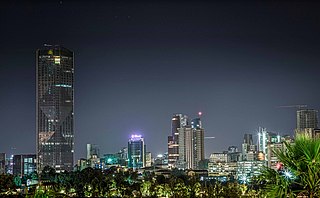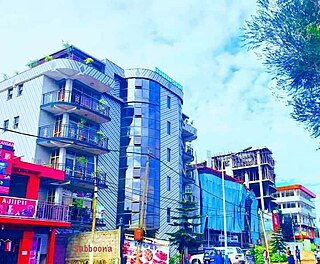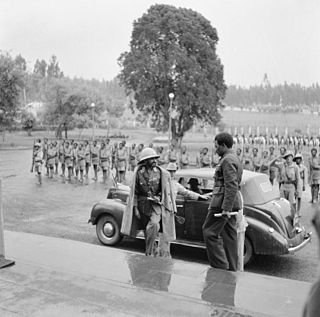
Haile Selassie I was Emperor of Ethiopia from 1930 to 1974. He rose to power as the Regent Plenipotentiary of Ethiopia under Empress Zewditu between 1916 and 1930. Widely considered to be a defining figure in modern Ethiopian history, he is accorded divine importance in Rastafari, an Abrahamic religion that emerged in the 1930s. A few years before he began his reign over the Ethiopian Empire, Selassie defeated Ethiopian army commander Ras Gugsa Welle Bitul, nephew of Empress Taytu Betul, at the Battle of Anchem. He belonged to the Solomonic dynasty, founded by Emperor Yekuno Amlak in 1270; Amlak's successors claimed that he was a lineal descendant of Menelik I, the legendary Emperor of Ethiopia who was supposedly born to King Solomon and Queen Makeda of the Kingdom of Israel and the Kingdom of Sheba, respectively. Historians regard the Solomonic lineage claim as unfounded, created by Amlak to justify wresting power from the Zagwe Dynasty.

Addis Ababa is the capital and largest city of Ethiopia. In the 2007 census, the city's population was estimated to be 2,739,551 inhabitants. Addis Ababa is a highly developed and important cultural, artistic, financial and administrative center of Ethiopia. It is widely known as one of Africa's major capitals.

Lij Iyasu was the designated Emperor of Ethiopia from 1913 to 1916. His baptismal name was Kifle Yaqob. Ethiopian emperors traditionally chose their regnal name on the day they were crowned, and since he was never crowned, he is usually referred to as Lij Iyasu, "Lij" meaning child, especially one born of royal blood.

RasMakonnen Wolde Mikael Wolde Melekot, or simply Ras Makonnen, also known as Abba Qagnew, was an Ethiopian royal from Shewa, a military leader, the governor of Harar, and the father of future Emperor Haile Selassie. Described by Nikolai Gumilev as “one of the greatest leaders of Abyssinia”, he served in the First Italo-Ethiopian War, playing a key role at the Battle of Adwa.

Zewditu was Empress of Ethiopia from 1916 until her death in 1930. She was officially renamed Zewditu at the beginning of her reign as Empress of Ethiopia. Once she succeeded the throne after Lij Yasu in 1916, she was described as the first modern-era female head in the nation of Africa. Her official coronation was on February 11th, 1917,held in the Cathedral of St. George in Addis Ababa—a capital founded by her father. She was forty years old, and childless when she was crowned empress. The first female head of an internationally recognized country in Africa in the 19th and 20th centuries, and the first and only empress regnant of the Ethiopian Empire, her reign was noted for the reforms of her Regent and designated heir Ras Tafari Makonnen, about which she was at best ambivalent and often stridently opposed, due to her staunch conservatism and strong religious devotion. She is the most recent empress regnant, as well as the last female Ethiopian head of state until the 2018 election of Sahle-Work Zewde as president. It is heard that she patterned her reign close to the British Queen Victoria’s legacy.

Ras BetwodedMekonnen Endelkachew was an Ethiopian aristocrat and Prime Minister under Emperor Haile Selassie. Mekonnen was born in Addisge, the nephew of the noted Shewan general and politician Ras Betwoded Tessema Nadew, who introduced him to Emperor Menelik II. He was a member of the alpha class of the Menelik II School in Addis Ababa when it opened in 1908.

Dembidollo, also spelled Dembi Dolo, is a market town and separate woreda in south-western Ethiopia. It is the capital of Kelam Welega Zone of the Oromia Region. This town, which is at an elevation of between 1,701 m (5,581 ft) and 1,827 m (5,994 ft) above sea level, was originally known as Sayo.

Nekemte, also spelled as Neqemte, is a market city and separate woreda in western Ethiopia. Located in the East Welega Zone of the Oromia Region, Nekemte has a latitude and longitude of 9°5′N36°33′E and an elevation of 2,088 meters.

RasDesta Damtew KBE was an Ethiopian noble, army commander and a son-in-law of Emperor Haile Selassie I. He is known for his leadership in the Ethiopian Army during the Second Italo-Ethiopian War. He was executed on 24 February 1937, by the Italian Armed Forces shortly after Ethiopia's loss in the war.

The history of Addis Ababa, capital of Ethiopia, formally begins with the founding of the city in the 19th century by Ethiopian Emperor Menelik II and his wife Empress Taytu Betul. In its first years the city was more like a military encampment than a town. The central focus was the emperor’s palace, which was surrounded by the dwellings of his troops and of his innumerable retainers. In the 1920s, Addis Ababa experienced a significant economic upturn, marked by a surge in the number of middle-class-owned buildings, including stone houses furnished with imported European furniture. The middle class also introduced newly manufactured automobiles and expanded banking institutions. Urbanization and modernization persisted during the Italian occupation, guided by a masterplan aimed at transforming Addis Ababa into a more "colonial" city, a trajectory that continued beyond the occupation. Subsequent master plans, formulated from the 1940s onward with the input of European consultants, focused on the development of monuments, civic structures, satellite cities, and the inner city.
Hailu Tekle Haymanot, also named Hailu II of Gojjam, was an army commander and a member of the nobility of the Ethiopian Empire. He represented a provincial ruling elite who were often at odds with the Ethiopian central government. Hailu Tekle Haymanot was an independent-minded potentate who, throughout his life, was mistrustful of and mistrusted by the Emperor.

LijAbiye Abebe was an Ethiopian politician and son-in-law of Emperor Haile Selassie.

The 1960 Ethiopian coup attempt was a failed coup d'état perpetrated against Emperor Haile Selassie on 13 December 1960 by the Council of the Revolution, a cabal of four conspirators led by brothers Germame Neway and Brigadier General Mengistu Neway, commander of the Kebur Zabagna, that sought to overthrow the Emperor during a state visit to Brazil in order to install a progressive government. The coup leaders declared the beginning of a new government under the rule of Haile Selassie's eldest son, Crown Prince Asfaw Wossen, that would address the numerous economic and social problems Ethiopia faced. The Council gained control of most of the capital city, Addis Ababa, and took several ministers and other important people hostage.

Italians of Ethiopia are Ethiopian-born citizens who are fully or partially of Italian descent, whose ancestors were Italians who emigrated to Ethiopia starting in the 19th century during the Italian diaspora, or Italian-born people in Ethiopia.

The Mayor of Addis Ababa is head of the executive branch of Addis Ababa's municipal government. The mayor's office is located in Addis Ababa City Hall. Adanech Abebe is the first woman mayor and 32nd mayor of Addis Ababa since 28 September 2021.

The Arbegnoch were Ethiopian anti-fascist World War II resistance fighters in Italian East Africa from 1936 until 1941 who fought against Fascist Italy's occupation of the Ethiopian Empire.

The monument to the Lion of Judah is a statue of the Lion of Judah, a symbol of Ethiopian Emperors and Ethiopia, and is located in Addis Ababa.

Prince Joel David Makonnen Haile Selassie of Ethiopia is an attorney, businessman, philanthropist, writer, and member of the Ethiopian Imperial House of Solomon. He is the great-grandson of Haile Selassie I, the last Emperor of Ethiopia.

Brazil–Ethiopia relations are the current and historical relations between Brazil and Ethiopia. Both nations are members of the Group of 77, BRICS and the United Nations.
This is chronology of the Ethiopian Revolution that took place from 12 January to 12 September 1974 in the Ethiopian Empire.


















